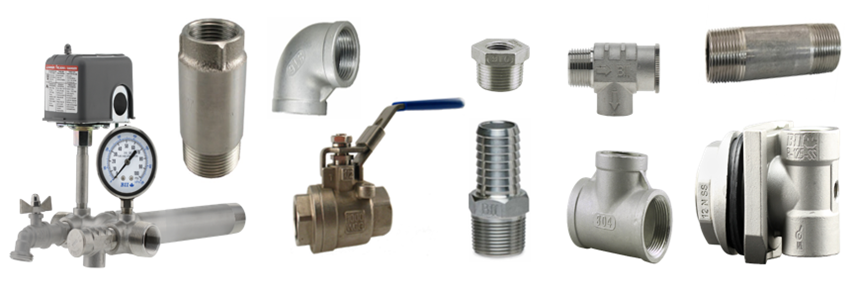Making NPT Connections
American National Standard Pipe Thread standards are often called national pipe thread standards (NPT) for short. You may also see the following short forms for female threaded fittings FNPT, FPT, and FIP and for male threads MNPT, MPT, and MIP.
Metal Fittings

A general guideline for making an NPT threaded connection for metal fittings is as follows:
After hand-tight engagement, tighten an additional:
1-½ to 3 full turns for sizes up to 1”
1 to 2-½" full turns for sizes 1-¼" and larger
You should have between 3-1/2 and 6 threads engaged. Thread engagement outside of this range may indicate either under or over tightening of the joint or out of tolerance threads. With experience you will know when the tightening force feels “right” and you will know when to stop tightening before you damage the fitting or valve.
STAINLESS STEEL INSTALLATION:

Visit the following link for installation requirements for making Stainless Steel NPT connections. Due to the extreme hardness of stainless alloys, and the issues regarding galling, the sealing of S.S. threaded connections can be much more challenging than when working with brass or bronze alloy fittings.
https://support.boshart.com/making-a-leak-proof-stainless-steel-threaded-connection
Sch. 40 & 80 PVC / Plastic Fittings

Making NPT connections with plastic pipe fittings requires more caution. One must avoid the temptation to over tighten joints by turning once more just to make sure.
A general guideline for making an NPT threaded connection for plastic fittings is:
After finger-tight engagement add one or two turns, no more
Two turns past finger tight, plus the stress of the system pressure will ensure it is within the tensile strength of PVC.
Threaded Male PVC fittings (MPT) have threads which increase in diameter whereas female threaded fittings (FPT) decrease in diameter. This is referred to as taper. Since the threads are tapered, any additional turns can cause the female part to undergo strain causing the plastic (PVC) female fitting to split. More strain is applied on smaller diameter fittings, so smaller fittings are more prone to stress cracking.
WARNING: Teflon* (PTFE) tape should not be used. Wrapping PTFE tape adds bulk and lubricates the joint, both of which increase the risk of the fitting cracking.
CAUTION: Teflon based paste or pipe dope thread sealants should be avoided, they act as a lubricant making it extremely easy to over torque.

Gray Magic Thread Sealing Compound is ideal for making PVC threaded connections as it is compatible with plastics including ABS, PVC, CPCV, Delrin*, Zytel*, Fiberglass, Nylon, Polypropylene, Polybutylene, Polyethylene, Celcon**, Cycolac***, and all types of metal. In addition, it does not contain any Teflon*(P.T.F.E.) which over lubricates and increases the tendency to over-tighten.
*Dupont registered trademark **Celanese registered trademark *** General Electric Plastics registered trademark
CAUTION: NPSM and NPTF threads
P.T.F.E. Thread Seal Tape or Thread Sealing Compounds such as Gray Magic are not for sealing NPSM threads. This is a straight thread with the same 60-degree angle as the NPT tapered pipe thread. NPSM threads can not form a seal using its thread, it needs an O-ring to form a seal.
The same is true for NPTF-to-NPTF joints or “Dry Seal Threads” which create a strong, leakproof, mechanical seal without using a sealant. Merchant steel fittings have NPTF (ASME B1.20.3) threads which are compatible with NPT threads. See the link below for more detail on making connections with NPFT threads.
